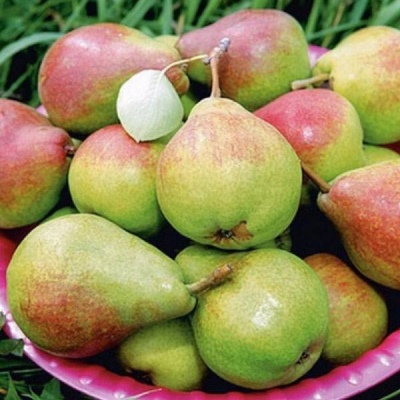
- Authors: Falkenberg E. A., Pankratova A. E. (FGBNU "Ural Federal Agrarian Research Center of the Ural Branch of the Russian Academy of Sciences")
- Appeared when crossing: Ussuriyskaya pear 41-16-1 x cultivated pear No. 143
- Year of approval: 2015
- Fruit weight, g: 160-280
- Ripening terms: autumn
- Fruit picking time: in mid-September
- Appointment: dessert
- Growth type: medium height
- Yield: high
- Height, m: 4-5
The Vekovaya pear variety was approved for use in 2015. It allows you to get a large full harvest, therefore it is very popular among gardeners.
Description of the variety
The Age-old pear belongs to the medium-sized species. A healthy adult tree can be about 4-5 meters tall. The crown is round. Shoots are also rounded brown. Average leafiness. The leaf blades are rather large, they are bright green in color, ovoid in shape. The surface of the leaves is slightly shiny.
Fruit characteristics
The shape of healthy fruits is pear-shaped and correct. They are large in size, the weight of one fruit can be approximately 160-280 grams. Their color is usually green-yellow.
The pulp of ripe fruits is tender, without splashes. Her color is white. The shelf life of plucked fruits is 1-1.5 months.
Taste qualities
Pears of this variety have a pleasant sweet and sour taste. The tasting score was 4.9 points.
Ripening and fruiting
The Age-old pear belongs to the autumn species. The dates for picking up the fruits are in mid-September. The frequency of fruiting is annual.

Yield
This variety has a high yield level.
Landing
When planting young seedlings of this pear, it is necessary to leave a free space between the plants of 3.5-4 meters. A distance of 4-5 meters is also maintained between individual rows.


Growing and care
Young seedlings are planted in autumn or spring. At the same time, it is necessary to choose the south side for landing. The place must be protected from winds.
The seats are dug in advance, their depth reaches 70-80 centimeters. At the bottom of each dug hole, a fertile soil layer consisting of peat and compost is laid.
The rhizome of young seedlings is carefully laid out on top. It is evenly located along the bottom of the holes made.The roots will need to be lightly sprinkled with earth. The soil around is compacted a little. After that, the soil must be watered abundantly.
To get the maximum yield, nutritious fertilizers should be applied in a timely manner. In the spring, it is worth adding fertilizing with nitrogen. It will allow you to build up green mass. In summer, it is used to stimulate the formation of ovaries.
Deficiency of this important element will lead to too early fall of the leaf plates, their yellowing. But an excessive amount of nitrogen can negatively affect these fruit trees, burns may appear on them, and harmful nitrates will begin to accumulate in the fruits.
Urea with nitrogen is often used. It is a concentrated composition that is often used for prophylactic purposes.
And also pears will need phosphorus. Without it, nitrogen will be poorly absorbed. In addition, this element will be responsible for the normal growth and development of the root system of plants, flowering and fruiting.
Most often, special mineral compositions with phosphorus are used for pears; they can be used both as root and as foliar feeding. It is also recommended to add superphosphate.
Young pears need potassium. It will ensure proper development and growth. In mature trees, this element can increase immunity. It is better to add potassium in the autumn season, so that closer to spring the substance is completely decomposed in the ground.
Complex fertilizers will be an excellent option for pears. Most often, they simultaneously contain potassium, phosphorus, nitrogen. Popular options are formulations such as diammophos, nitrophoska.
Spraying the crown in the spring with complex fertilizers allows you to stimulate tree growth, strengthen immunity, and improve fruiting. Moreover, this procedure can be carried out for both young and adult plants.
Organic fertilizers also play an important role. The most commonly used manure and humus. Sometimes bird droppings are also used, but it can only be taken in the spring. This substance will stimulate the growth of vegetation.
Wood ash is also a valuable organic fertilizer. It allows you to reduce the level of soil acidity, replaces potash fertilizing. In addition, it contains a large amount of essential macronutrients and micronutrients.
It is worth remembering that the pear needs periodic pruning. It should be done in the spring. During this procedure, old and damaged diseased branches should be removed. In this case, all the places of the cuts will need to be treated with special disinfectants or just whitewashing.
We must not forget about regular watering. On average, one tree should take 30 liters of water. With the onset of hot dry weather, such procedures will need to be carried out only in the evening.




Like any other fruit trees, the pear needs protection from various diseases and pests. When planting a pear on your site, you need to know in advance what diseases you should beware of.To successfully carry out the struggle, it is necessary first to correctly identify the cause of the problem. It is important to distinguish signs of disease from manifestations of the presence of insects, mites, caterpillars and other types of pests.





































































